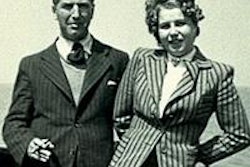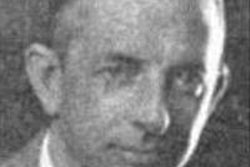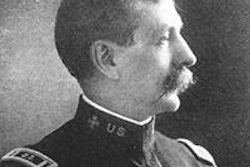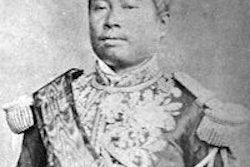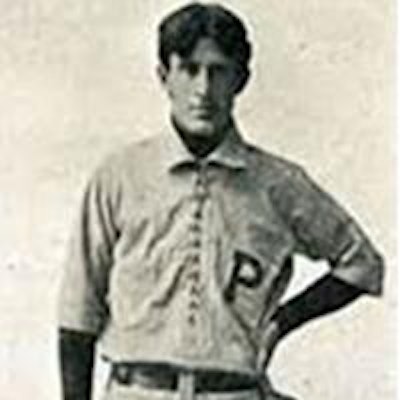
It's hard to fathom what kind of parents give their son a girl's name. Surely they can't be oblivious to the virtual certainty that the child will be forced to fight throughout his life, like the Johnny Cash song "A Boy Named Sue" proclaims. Such, though, was the case of Dr. Lewis Grey, who named his son "Pearl." Grey, an Ohio farmer, became a dentist in 1861 by apprenticing himself with an established dentist -- the professional norm at the time.
His son Pearl Zane Grey was born in 1872, the fourth of five children. According to anecdotal histories, the name was derived from newspaper accounts about the mourning attire of Queen Victoria's court after the premature death of her husband, Prince Albert. Regardless of its origin, the female name "caused [Pearl] much taunting and embarrassment," wrote Thomas Pauly, a professor of English at the University of Delaware.
Pearl, just like in Cash sang, "grew up quick and grew up mean." He described himself as a "juvenile delinquent." He hated school, was a poor student, and never graduated from high school. He constantly disobeyed his parents. He was a petty thief and engaged in countless fist fights. Pauly wrote that "[Pearl] hurled himself into combat with disturbing relish and ferocity, flinging stones without regard for potential injury." In one instance, he knocked a boy out with a rock; in another, he sent a boy "he toppled with a brick" to the hospital. On yet another occasion, he kicked a boy in the face whom he had just knocked to the ground. His irascible behavior, in his own words, led to "many a poignant acquaintance with the apple switch."
A number of psychological studies completed long after Pearl's death substantiate that "boys with girly sounding names have more behavioral problems," wrote Time's Bonnie Rochman. Jeanna Bryner in a 2010 LiveScience article reinforces Rochman's contention, claiming "research suggests [that] boys with names traditionally given to girls are more likely to misbehave than their counterparts with masculine names." Partly it is surmised that this misbehavior stems from these boys' insecurity, which drives them to constantly prove their masculinity.
 Pearl Zane Grey.
Pearl Zane Grey.
As Grey transitioned from adolescence, he discovered girls, which led to even more fights with protective brothers and jealous boyfriends. At 15 he was arrested in a police raid at a local brothel and spent a night in jail. Womanizing would become a lifelong affliction.
In his teens, he found an outlet to his wayward behavior in baseball and fishing -- two sports at which he excelled. Because of his father's financial setbacks, at 14 he found himself assisting in his dental offices. A year later, Grey was sent on his own into small rural towns outside of Columbus, OH, to perform basic extractions. His father trained him in the use of cocaine, a newly discovered alkaloid used as a topical numbing agent at the time.
According to Pauly, "rural Ohio was so sufficiently free of regulation that [Pearl] was able to practice dentistry" without the required license. At the same time, to avoid process servers and the shame associated with his financial reversals, his father changed the spelling of the family name from its original "Gray" to "Grey."
Pearl's baseball talent was noticed by several universities, including Ohio Wesleyan, Vanderbilt, and the universities of Michigan and Pennsylvania. He chose Penn partly because it had a winning record against the nation's best collegiate baseball teams, but also because it had a dental school. In the 1890s, collegiate athletics were as big (if not bigger) than professional sports, and the nation's colleges and universities sought the best to enhance their reputation and the revenues they generated. Also, the application process at Penn was much easier than the others, as a high school diploma was not required.
Penn offered him a scholarship as a pitcher. He later became the team's right fielder. While at Penn, true to his womanizing ways, he became the defendant in a paternity suit, which he settled by paying the mother of his child $133 (roughly $4,500 in 2013 dollars).
In 1896, Grey graduated from Penn's dental school at age 23. He continued to play baseball after his graduation, hoping to be drafted by a professional team. He practiced dentistry, but only part time as he pursued his dream of becoming a major league player. One of Grey's biographers, Frank Gruber, claimed, "Grey was making more money at this time from baseball than dentistry."
In 1897, he played for a semiprofessional team in Newark, NJ. His batting average, however, declined, and in 1898 he began to practice dentistry, opening an office in an impoverished area of New York City. Pauly relates that Grey's meager income found him "so destitute that he once went four days without eating." At about the same time, he became an avid reader and developed an ambition to become a writer. With limited income, he wrote "in the dim light over the kitchen table in his 'dingy' office late at night," according to Pauly, who added that Grey's efforts "were hampered by a consciousness that he had been a poor student, especially in English classes."
Grey met his future wife, Dolly, in 1900. She was eleven years younger and was studying to be a school teacher. She came from an old Manhattan family, and both her father and grandfather were successful doctors. She was a trust-fund girl who routinely received annual fund distributions averaging $1,771 per year (roughly $56,000 in 2013 dollars).
As their romance blossomed, Dolly, who had taken many college level English classes and understood the fundamentals of good writing, offered to assist him in his endeavors. During their six-year courtship, he once wrote to Dolly, "I want to be somebody. I want fame." The two were married in 1906, and with her trust and editing skills, Grey was able to quit dentistry and concentrate on his writing. In 1901, he dropped "Pearl" from his name and from then on used his middle name "Zane" as his moniker.
As Zane Grey, he would essentially define the Western novel genre. His stories were filled with descriptions of the American West, which he explored (before autos and highways) on horseback with guides. For example, he was one of the first white men to see the cliff dwellings at Mesa Verde in Colorado and the Rainbow Arch (now Arches National Park) in Utah.
His novels were so popular and generated so much income that he was able to become a great explorer and adventurer. He wrote articles about his annual hunting and fishing trips for Field & Stream, Argosy, and other sportsmen magazines of the era. For example, he lassoed mountain lions in the Grand Canyon and hunted grizzlies in Nevada and Colorado and jaguars in the jungles of Mexico. He fished the seven seas where he set 12 world angling records: the largest tuna (Nova Scotia, 758 lb), sailfish (Mexico, 135 lb), yellowtail (New Zealand, 111 lb), dolphin (Tahiti, 63 lb), tiger shark (Australia, 1,036 lb), and striped marlin (Tahiti, 1,040 lb). All his records were later eclipsed.
Grey was also a dedicated conservationist. In 1904, the nation's buffalo population had dwindled to fewer than 1,000. President Teddy Roosevelt then decided to use Yellowstone National Park as a preserve for the animals, and Grey was appointed the park's first game warden. As game warden, he oversaw the transportation of buffalo from Texas and the construction of a compound.
During his lifetime, Grey wrote 35 novels and nine books about his travels, fishing, and outdoor adventures. Sales of his books were exceeded only by the Bible and the "Boy Scout Handbook." He was such a prolific writer that when he died in 1937, his publishers had 24 unpublished manuscripts in their files. They published one each year until 1963. Additionally, he formed his own movie production company to turn his novels into movies, becoming one of the first producers to shoot movies onsite (in Arizona, Colorado, Oregon, and Utah), away from the Hollywood studios.
Pearl Zane Grey certainly achieved his ambition. He became somebody and achieved great fame. Still, one can't help but wonder if this dentist's feminine first name influenced his ambition and subsequent success. He certainly hated the name, and to paraphrase Johnny Cash, he most likely wished he was named "Bill, or George! Anything but [Pearl]."
Daniel Demers is a semiretired businessman whose hobby is researching and writing about 19th and 20th century historical events and personalities. He holds a bachelor's degree in history from George Washington University and a master's degree in business from Chapman University. You can review his other published works at www.danieldemers.com.
Sources
Books
Gruber F. Zane Grey: A Biography. New York, NY: World Publishing; 1970.
Pauly TH. Zane Grey: His Life, His Adventures, His Women. Chicago, IL: University of Illinois Press; 2007.
Articles
Bryner J. Good or bad, baby names have long-lasting effects. LiveScience, June 13, 2010. https://www.livescience.com/6569-good-bad-baby-names-long-lasting-effects.html. Accessed August 13, 2013.
Rochman B. Baby name game: How a name can affect your child's future. Time, Health & Family, December 2, 2011. https://healthland.time.com/2011/12/02/how-baby-names-affect-your-childs-future/. Accessed August 13, 2013.
Websites
Arches National Park. UtahArches.com website. http://www.utaharches.com/ANP/rainbowarch.html. Accessed August 15, 2013.
Mesa Verde National Park. Wikipedia website. https://en.wikipedia.org/wiki/Mesa_Verde_National_Park. Accessed August 15, 2013.
Pearl Grey. Wiktionary website. https://en.wiktionary.org/wiki/pearl_grey. Accessed August 14, 2013.
Tom's inflation calculator. https://www.halfhill.com/inflation.html. Accessed August 14, 2013.
Zane Grey. Wikipedia website. https://en.wikipedia.org/wiki/Zane_Grey. Accessed August 14, 2013.




